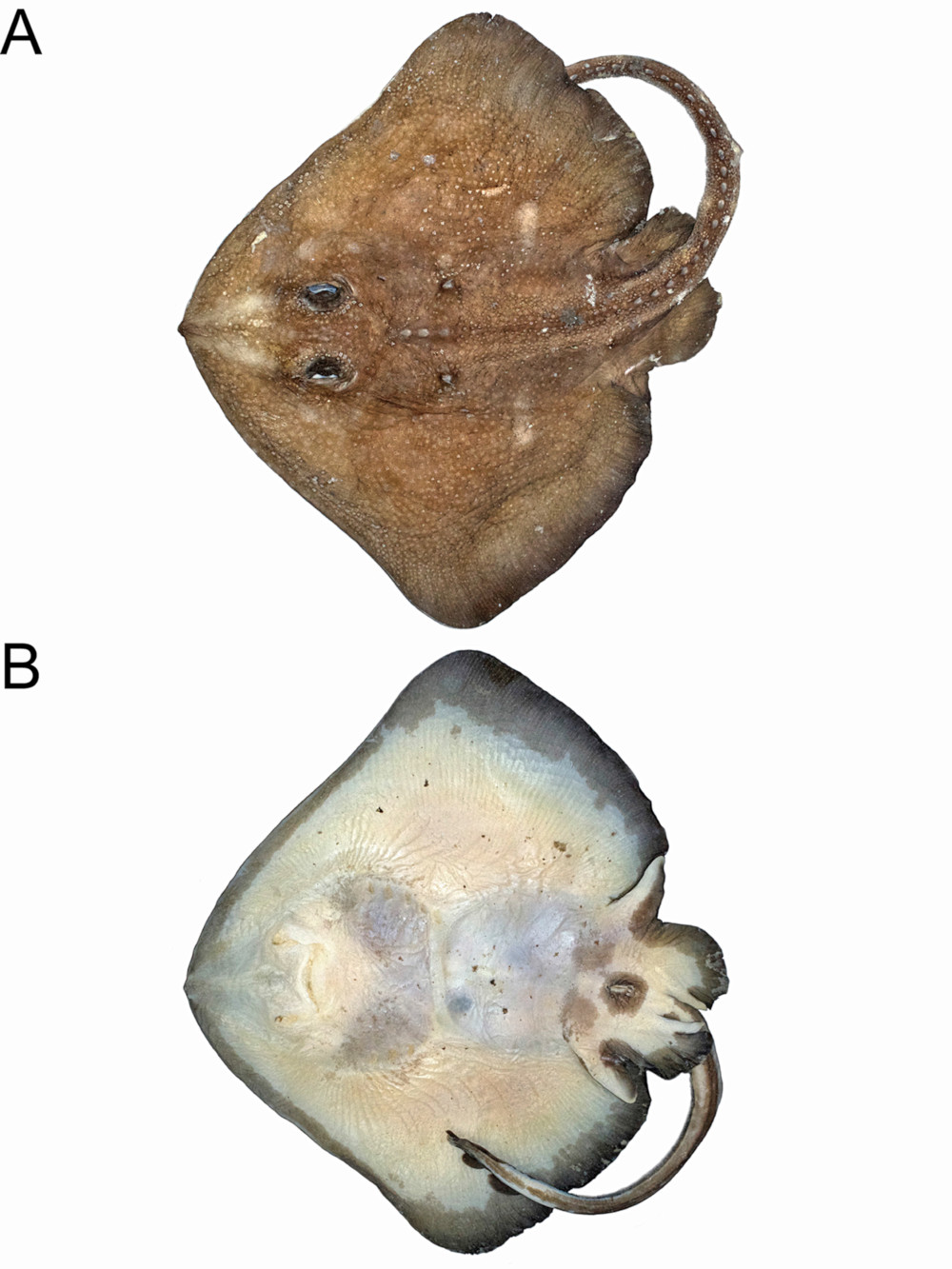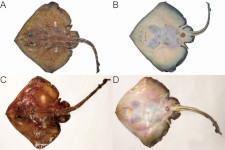Arctoraja sexoculata
(Misawa, Orlov, Orlova, Gordeev & Ishihara, 2020)
Classification: Elasmobranchii Rajiformes Rajidae
Reference of the original description
Bathyraja (Arctoraja) sexoculata sp. nov., a new softnose skate (Rajiformes: Arhynchobatidae) from Simushir Island, Kuril Islands (western North Pacific), with special reference to geographic variations in Bathyraja (Arctoraja) smirnovi. Zootaxa, 4861(4), 515–543
Bathyraja (Arctoraja) sexoculata sp. nov., a new softnose skate (Rajiformes: Arhynchobatidae) from Simushir Island, Kuril Islands (western North Pacific), with special reference to geographic variations in Bathyraja (Arctoraja) smirnovi. Zootaxa, 4861(4), 515–543
Synonyms / new combinations and misspellings
Bathyraja sexoculata, Bathyraja (Arctoraja) sexoculata
Bathyraja sexoculata, Bathyraja (Arctoraja) sexoculata
Types
Arctoraja sexoculata
Bathyraja (Arctoraja) sexoculata
Holotype: ZMMU: P 24098; Paratype: ZMMU: P 24095; ZMMU: P 24096; ZMMU: P 24097; ZMMU: P 24099;
Arctoraja sexoculata
Bathyraja (Arctoraja) sexoculata
Holotype: ZMMU: P 24098; Paratype: ZMMU: P 24095; ZMMU: P 24096; ZMMU: P 24097; ZMMU: P 24099;
Description :
Citation: Arctoraja sexoculata (Misawa, Orlov, Orlova, Gordeev & Ishihara, 2020): In: Database of modern sharks, rays and chimaeras, www.shark-references.com, World Wide Web electronic publication, Version 01/2026
Please send your images of "Arctoraja sexoculata" to info@shark-references.com

Bathyraja (Arctoraja) sexoculata (Misawa, Orlov, Orlova, Gordeev & Ishihara, 2020), ZMMU-P 24098, holotype, 346 mm TL, immature male, preserved © MISAWA, ORLOV, ORLOVA, GORDEEV & ISHIHARA

Bathyraja (Arctoraja) sexoculata (Misawa, Orlov, Orlova, Gordeev & Ishihara, 2020), ZMMU-P 24098, holotype, 346 mm TL, immature male, preserved © MISAWA, ORLOV, ORLOVA, GORDEEV & ISHIHARA
Common names
 Simushir skate, Cимуширский скат (russian)
Simushir skate, Cимуширский скат (russian)
 Simushir skate, Cимуширский скат (russian)
Simushir skate, Cимуширский скат (russian)
Short Description
Diagnosis after MISAWA, ORLOV, ORLOVA, GORDEEV & ISHIHARA, 2020 [29011]: A medium-sized species (approximate maximum size 800 mm TL, 550 mm DW) of Bathyraja (Arctoraja) with the following combination of characters: dorsal ground color reddish-brown or greenish-brown, with three pairs of white blotches on disc located beside eyes, and on shoulders and posterior half of disc; lateral margin of tail with four or five pairs of white blotches located at tail origin, midpoint, D1 origin, and on inter-dorsal space; ventral surface almost entirely white; dark blotch around cloaca, dark bands along mid ventral line of tail; dorsal surface of disc with a single scapular thorn, 3–4 nuchal thorns; tail with 20–24 regularly arranged thorns; median row of thorns discontinuous, viz., mid-dorsal thorns absent; orbital thornlets present along medial rim of orbit; fine prickles on dorsal surface of disc and tail; prickle band on mid-disc extending along sides of tail; prickles on pectoral fin base relatively sparse; ventral surface uniformly smooth; disc width 63.1–65.6% TL, length 50.6–53.5% TL; anterior projection (snout to maximum width) 29.7–32.2% TL; head length (dorsal aspect) 18.9–20.6% TL; snout broad, moderately short, preoral length 11.1–14.1% TL, supported by slender, flexible unsegmented cartilage; snout angle 103–119º; eyes rather large, eye diameter 0.22–0.24 times head length, 1.00–1.11 times between orbits; tail relatively long (but shorter than disc width), length 51.5–54.1% TL and 0.79–0.86 times DW, width at first dorsalfin origin 3.8–4.2% tail length; 86–93 predorsal caudal vertebrae.
Diagnosis after MISAWA, ORLOV, ORLOVA, GORDEEV & ISHIHARA, 2020 [29011]: A medium-sized species (approximate maximum size 800 mm TL, 550 mm DW) of Bathyraja (Arctoraja) with the following combination of characters: dorsal ground color reddish-brown or greenish-brown, with three pairs of white blotches on disc located beside eyes, and on shoulders and posterior half of disc; lateral margin of tail with four or five pairs of white blotches located at tail origin, midpoint, D1 origin, and on inter-dorsal space; ventral surface almost entirely white; dark blotch around cloaca, dark bands along mid ventral line of tail; dorsal surface of disc with a single scapular thorn, 3–4 nuchal thorns; tail with 20–24 regularly arranged thorns; median row of thorns discontinuous, viz., mid-dorsal thorns absent; orbital thornlets present along medial rim of orbit; fine prickles on dorsal surface of disc and tail; prickle band on mid-disc extending along sides of tail; prickles on pectoral fin base relatively sparse; ventral surface uniformly smooth; disc width 63.1–65.6% TL, length 50.6–53.5% TL; anterior projection (snout to maximum width) 29.7–32.2% TL; head length (dorsal aspect) 18.9–20.6% TL; snout broad, moderately short, preoral length 11.1–14.1% TL, supported by slender, flexible unsegmented cartilage; snout angle 103–119º; eyes rather large, eye diameter 0.22–0.24 times head length, 1.00–1.11 times between orbits; tail relatively long (but shorter than disc width), length 51.5–54.1% TL and 0.79–0.86 times DW, width at first dorsalfin origin 3.8–4.2% tail length; 86–93 predorsal caudal vertebrae.
Size / Weight / Age
TL (max, types): 286–352 mm TL, 187–226 mm DW, uncatalogued specimens: adult male: ca. 810 mm TL, ca. 550 mm DW; immature female: ca. 630 mm TL, ca. 450 mm DW [29011]
TL (max, types): 286–352 mm TL, 187–226 mm DW, uncatalogued specimens: adult male: ca. 810 mm TL, ca. 550 mm DW; immature female: ca. 630 mm TL, ca. 450 mm DW [29011]
Dentition
Teeth unicuspid, with slightly elevated subcircular bases; arranged regularly in parallel longitudinal rows; cusps weakly pointed, conical, directed obliquely posteriorly in upper jaw; cusps more flattened in lower jaw. [29011]
Teeth unicuspid, with slightly elevated subcircular bases; arranged regularly in parallel longitudinal rows; cusps weakly pointed, conical, directed obliquely posteriorly in upper jaw; cusps more flattened in lower jaw. [29011]
Remarks
shark-references Species-ID=16029;
shark-references Species-ID=16029;
Parasites (arranged by Jürgen Pollerspöck)
Cestoda
Cestoda


















